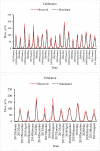The impacts of climate change on hydrological processes of Gilgel Gibe catchment, southwest Ethiopia
- PMID: 37379295
- PMCID: PMC10306186
- DOI: 10.1371/journal.pone.0287314
The impacts of climate change on hydrological processes of Gilgel Gibe catchment, southwest Ethiopia
Abstract
Climate change is a significant driver of water resource availability, affecting the magnitude of surface runoff, aquifer recharge, and river flows. This study investigated the impact of climate change on hydrological processes within the Gilgel Gibe catchment and aimed to determine the level of exposure of water resources to these changes, which is essential for future adaptability planning. To achieve this objective, an ensemble mean of six regional climate models (RCMs) from the coordinated regional climate downscaling experiment (CORDEX)-Africa was used to simulate future climatic scenarios. The RCMs outputs were then bias corrected using distribution mapping to match observed precipitation and temperature. The Soil and Water Assessment Tool (SWAT) model was used to assess the hydrological impacts of climate change on the catchment. The results indicated that the ensemble mean of the six RCMs projects a decline in precipitation and an increase in temperature under both the RCP4.5 and RCP8.5 representative concentration pathways. Moreover, the increases in both maximum and minimum temperatures are higher for higher emission scenarios, indicating that RCP8.5 is warmer than RCP4.5. The projected climate change shows a decrease in surface runoff, groundwater, and water yield, resulting in an overall decline of annual flow. This decline is mainly due to the reduction in seasonal flows driven by climate change scenarios. The changes in precipitation range from -11.2% to -14.3% under RCP4.5 and from -9.2% to -10.0% under RCP8.5, while the changes in temperature range from 1.7°C to 2.5°C under RCP4.5 and from 1.8°C to 3.6°C under RCP8.5. These changes could lead to reduced water availability for crop production, which could be a chronic issue for subsistence agriculture. Additionally, the reduction of surface water and groundwater could further exacerbate water stress in the downstream areas, affecting the availability of water resources in the catchment. Furthermore, the increasing demands for water, driven by population growth and socioeconomic progress, along with the variability in temperature and evaporation demands, will amplify prolonged water scarcity. Therefore, robust climate-resilient water management policies are indispensable to manage these risks. In conclusion, this study highlights the importance of considering the impact of climate change on hydrological processes and the need for proactive adaptation measures to mitigate the impacts of climate change on water resources.
Copyright: © 2023 Tilahun et al. This is an open access article distributed under the terms of the Creative Commons Attribution License, which permits unrestricted use, distribution, and reproduction in any medium, provided the original author and source are credited.
Conflict of interest statement
The authors have declared that no competing interests exist.
Figures


















References
-
- Kasperson J. X., Kasperson R. E., Turner B. L., Hsieh W., & Schiller A. (2022). Vulnerability to global environmental change. In The social contours of risk (pp. 245–285). Routledge.
-
- Al‐Ghussain L. (2019). Global warming: Review on driving forces and mitigation. Environmental Progress & Sustainable Energy, 38(1), 13–21.
-
- IPCC. (2021). Sixth Assessment Report (AR6). Intergovernmental Panel on Climate Change. https://www.ipcc.ch/report/ar6/
-
- Lindersson S., Brandimarte L., Mård J., & Di Baldassarre G. (2020). A review of freely accessible global datasets for the study of floods, droughts and their interactions with human societies. Wiley Interdisciplinary Reviews: Water, 7(3), e1424.
MeSH terms
LinkOut - more resources
Full Text Sources
Medical

